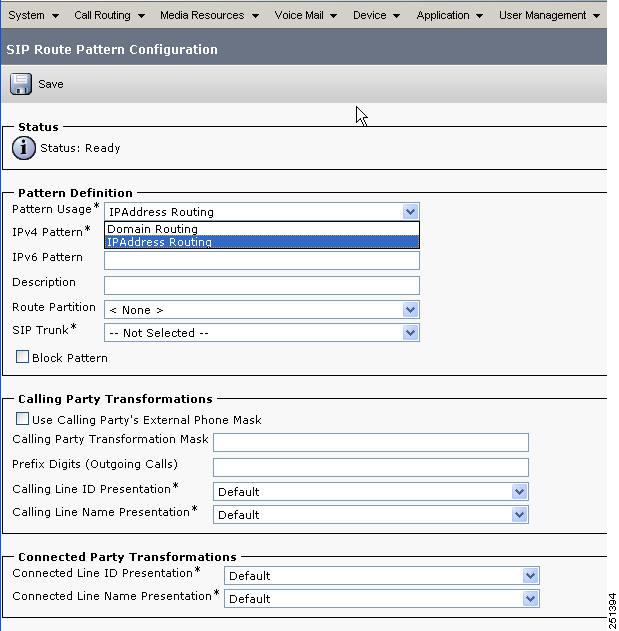

-
Deploying IPv6 in Unified Communications Networks with Cisco Unified Communications Manager
-
Preface
-
Introduction
-
IPv6 Basics
-
IPv6 Support in Cisco Unified Communications Devices
-
Unified Communications Deployment Models for IPv6
-
Network Infrastructure
-
Gateways
-
Trunks
-
Media Resources and Music on Hold
-
Call Processing and Call Admission Control
-
Dial Plan
-
Applications
-
IP Video Telephony
-
IP Telephony Migration Options
-
Security
-
Unified Communications Endpoints
-
Configuring IPv6 in Cisco Unified CM
-
Configuring Cisco Integrated Services Routers
-
Configuring Cisco VG224 Analog Voice Gateway
-
Configuring Cisco IOS Gateways
-
Table Of Contents
IPv6 and Unified CM Dial Plans
Path Selection Considerations for IPv6 Calls
Call Routing in Cisco IOS with SIP IPv6 Dial Peers
Dial Plan
Revised: June 08, 2010; OL-19142-02
The dial plan is one of the key elements of a Unified Communications system, and an integral part of all call processing agents. Generally, the dial plan is responsible for instructing the call processing agent on how to route calls. Specifically, the dial plan performs the following main functions:
•
Endpoint addressing
Reachability of internal destinations is provided by assigning directory numbers (DNs) to all endpoints.
•
Path selection
Depending on the calling device, different paths can be selected to reach the same destination.
•
Calling privileges
Different groups of devices can be assigned to different classes of service, by granting or denying access to certain destinations.
•
Digit manipulation
In some cases, it is necessary to manipulate the dialed string before routing the call.
•
Call coverage
Special groups of devices can be created to handle incoming calls for a certain service according to different rules (top-down, circular hunt, longest idle, or broadcast).
For general dial plan guidance and design considerations, refer to the Cisco Unified Communications Solution Reference Network Design (SRND), available at http://www.cisco.com/go/ucsrnd.
IPv6 and Unified CM Dial Plans
The deployment of IPv6 with Cisco Unified Communications Manager (Unified CM) affects two areas of dial plan functionality:
•
IPv6 addressing for SIP route patterns
•
Path selection considerations for IPv6 calls over IPv6-capable networks
SIP IPv6 Route Patterns
Cisco Unified CM can use SIP route patterns to route or block both internal and external calls to SIP endpoints. SIP route patterns can use the destination domain name, an IPv4 address, or an IPv6 address to provide a match for call routing.
A SIP request to call a device can take either of the following forms:
•
Using an address:
INVITE sip:5001@2001:0db8:2::1 5060 SIP/2.0
•
Using a domain name:
INVITE sip:5001@example.com 5060 SIP/2.0
To process the SIP request, the Unified CM administrator can add domains, IP addresses, and IP network addresses, and associate them to SIP trunks (only), as shown in Figure 10-1. This method allows requests that are destined for these domains to be routed through particular SIP trunk interfaces.
Figure 10-1 SIP Route Pattern Configuration in Unified CM
The following guidelines and examples apply to SIP route patterns:
•
Domain name examples:
–
example.com
–
my-pc.example.com
–
*.com
–
rtp-ccm[1-5].example.com
•
Valid characters for domain names:
[, -, ., 0-9, A-Z, a-z, *, and ]
•
If domains names are used, then DNS must be configured in the Unified CM cluster.
•
IPv4 address examples:
–
192.168.201.119 (explicit IP host address)
–
192.168.0.0/16 (IP network)
•
IPv6 address examples:
–
2001:0db8:2::1 (explicit IPv6 host address)
–
2001::/16 (IPv6 network)
•
Valid characters for IPv6 addresses:
0-9, A-F, :, and /
Path Selection Considerations for IPv6 Calls
If you create an IPv6 route pattern, then that route pattern must be associated with an IPv6-capable SIP trunk. Likewise, the campus network or WAN that the IPv6 call traverses must be IPv6-capable.
Call Routing in Cisco IOS with SIP IPv6 Dial Peers
The following example shows a typical Cisco IOS IPv6 dial peer. Note that Alternative Network Address Types (ANAT) has been configured on this dial peer, thus allowing either an IPv4 address or IPv6 address to be negotiated for media. The session target can be configured with only one address, either IPv4 or IPv6.
dial-peer voice 1 voipdescription **** SIP Trunk to CUCM ****destination-pattern 5...voice-class sip anatsession protocol sipv2session target ipv6:[2001:db8:caf0:101:21b:78ff:fe7a:5d86]session transport tcpdtmf-relay rtp-nteno vadFor a complete example of Cisco IOS ANAT configuration and IPv6 dial peers, see Configuring Cisco IOS Gateways, page D-1
Emergency Services
Cisco Emergency Responder is used to locate (by access switch or IPv4 subnet) IP devices that make emergency calls. Cisco Emergency Responder supports IPv4 only. Cisco Emergency Responder can support dual-stack devices by using the IPv4 address of the device. IPv6-only devices are not supported.
Cisco Emergency Responder interfaces with the following components:
•
A Unified CM cluster by the following methods:
–
SNMP, to collect information about its configured phones
–
JTAPI, to allow for the call processing associated with redirection of the call to the proper PSAP gateway
•
The access switches (through SNMP) where the phones associated with Unified CM are connected.

 Feedback
Feedback